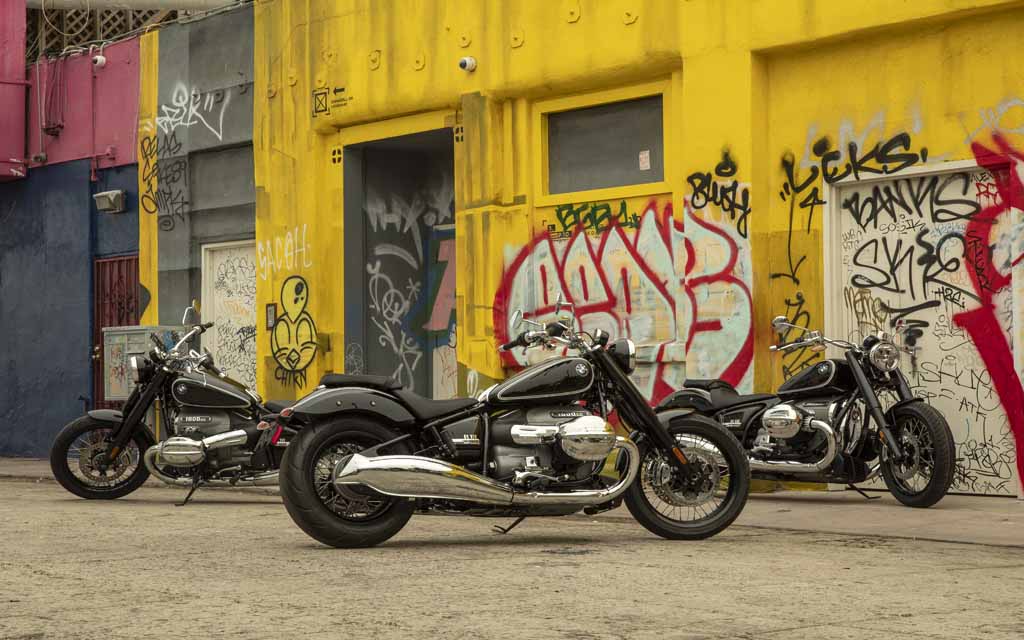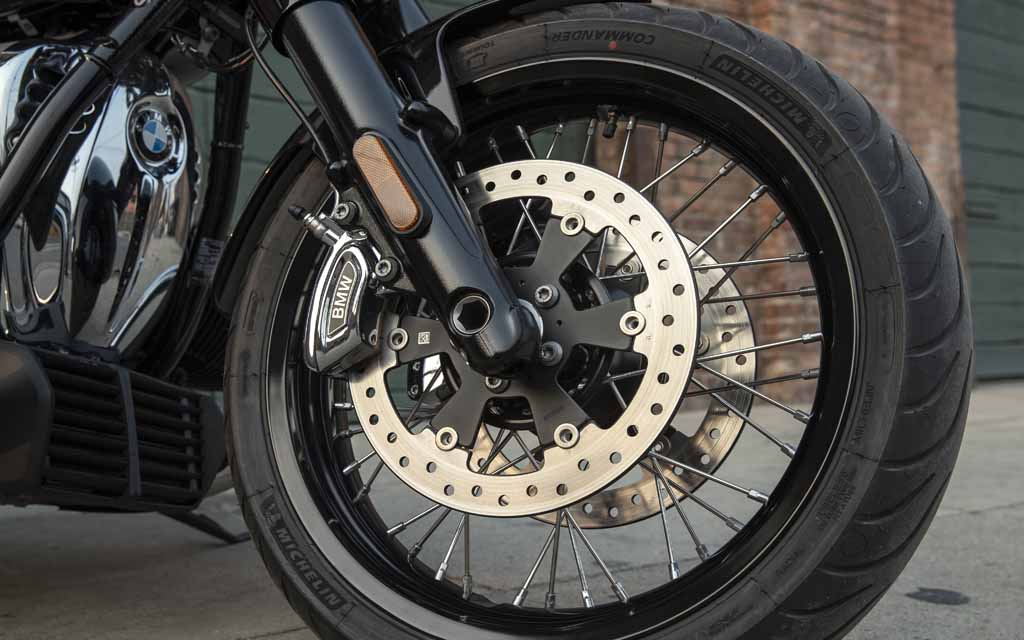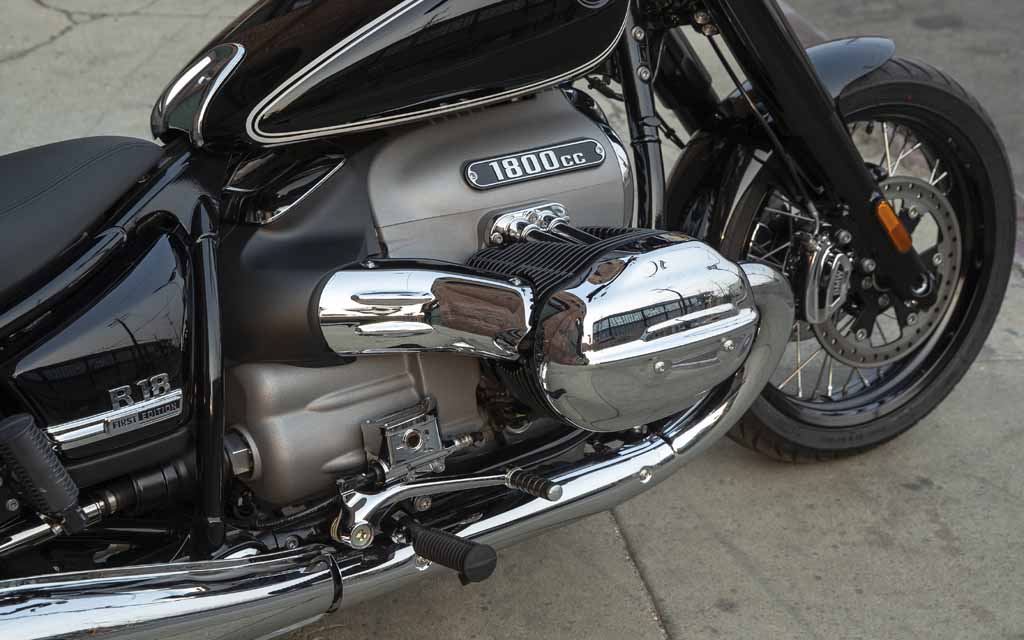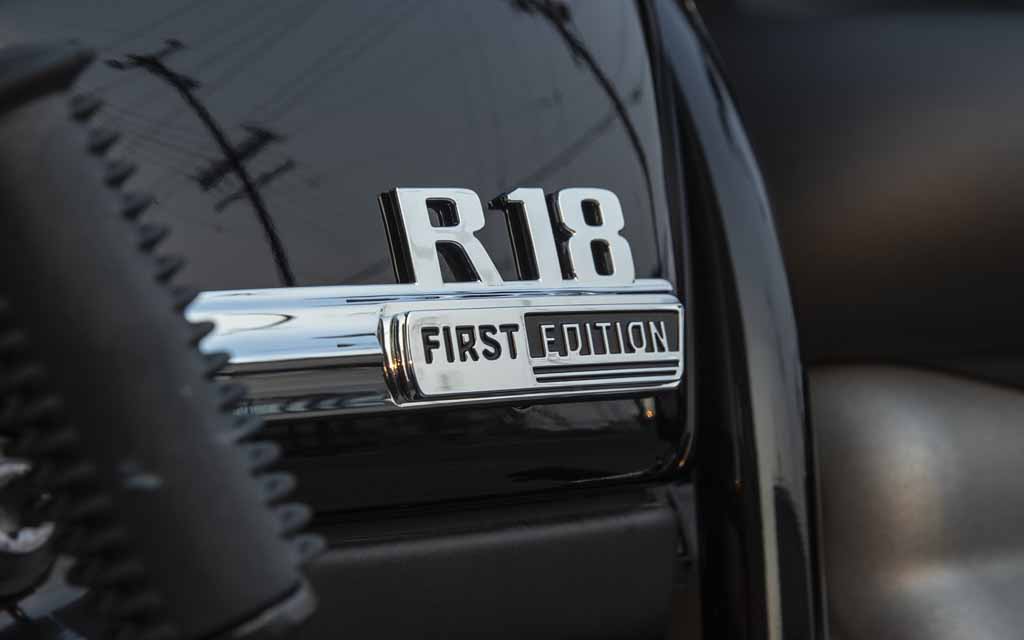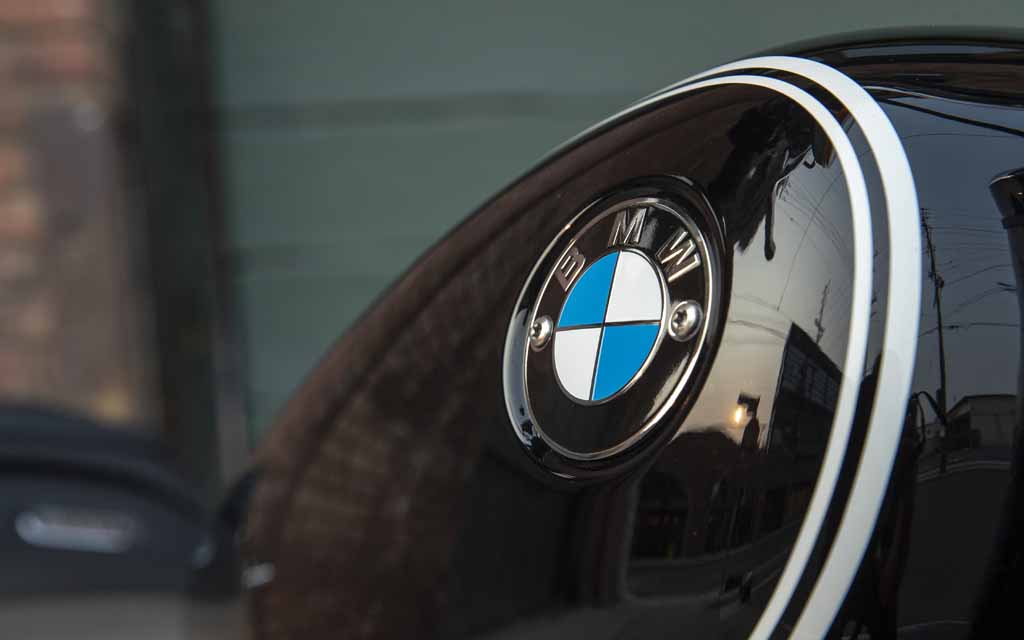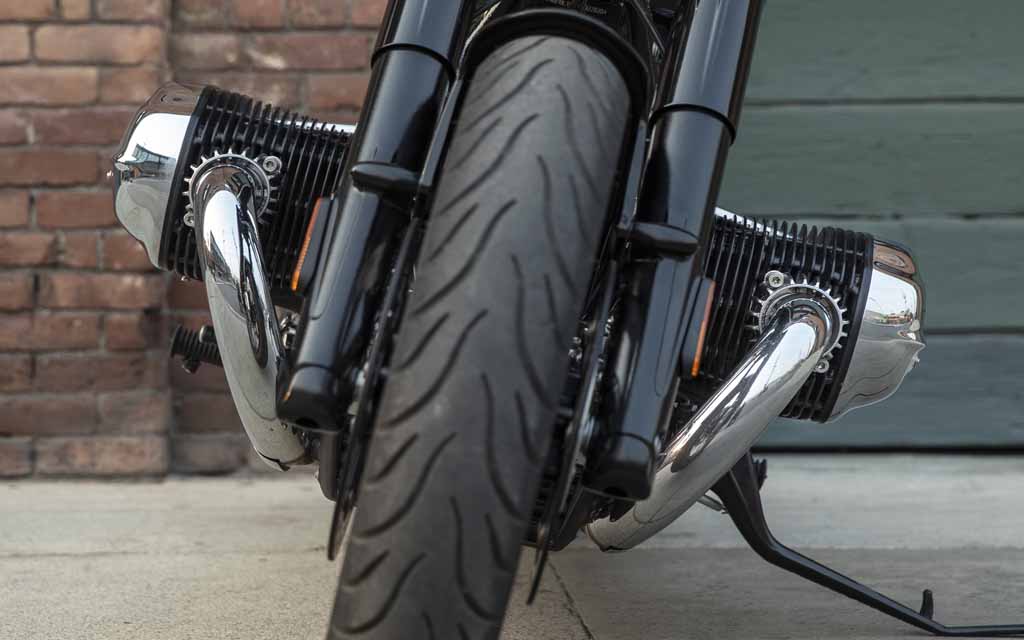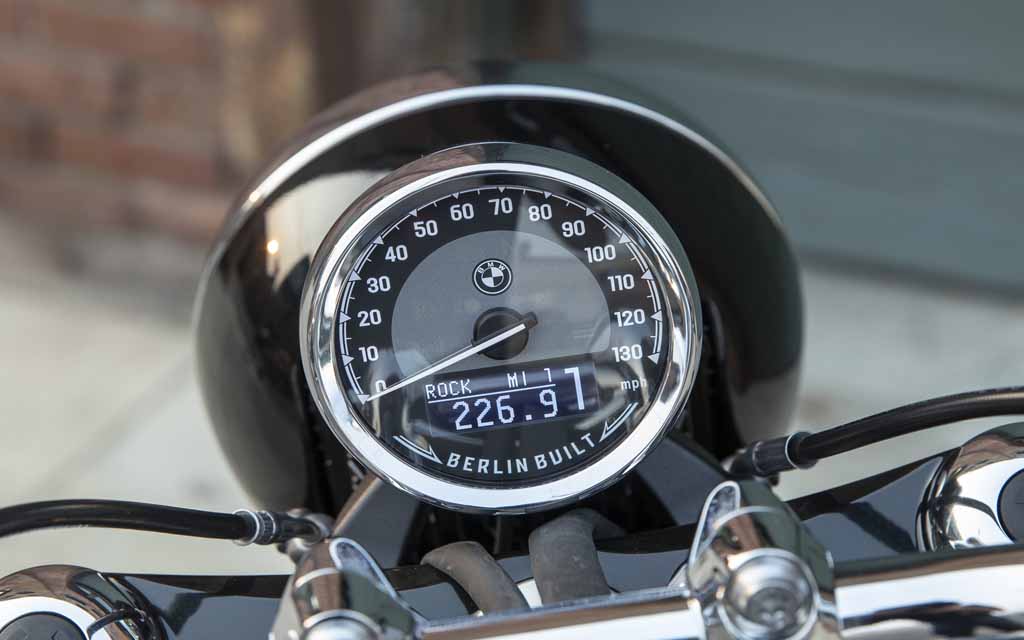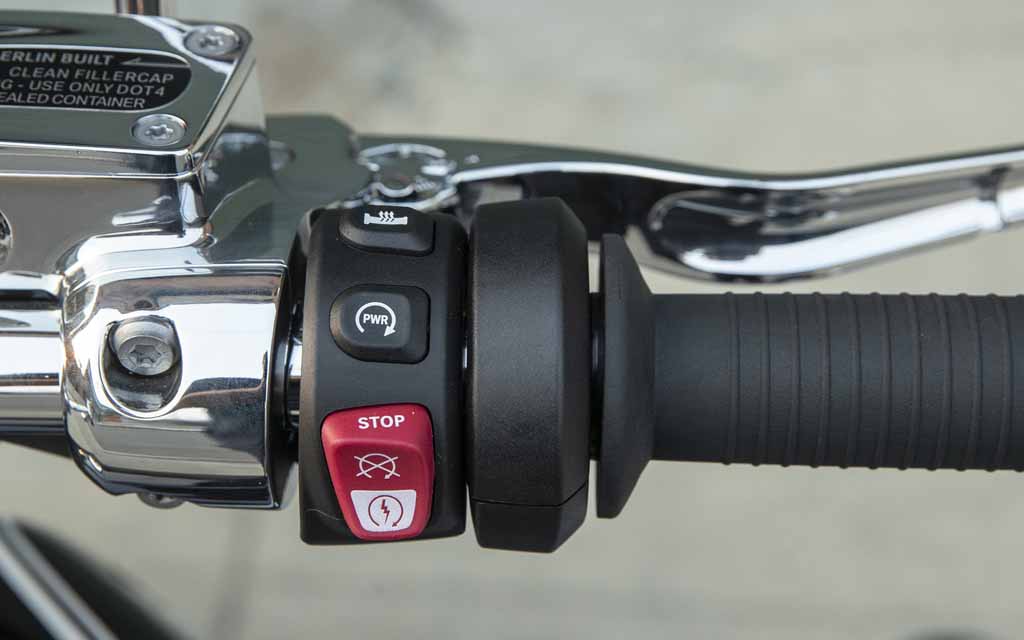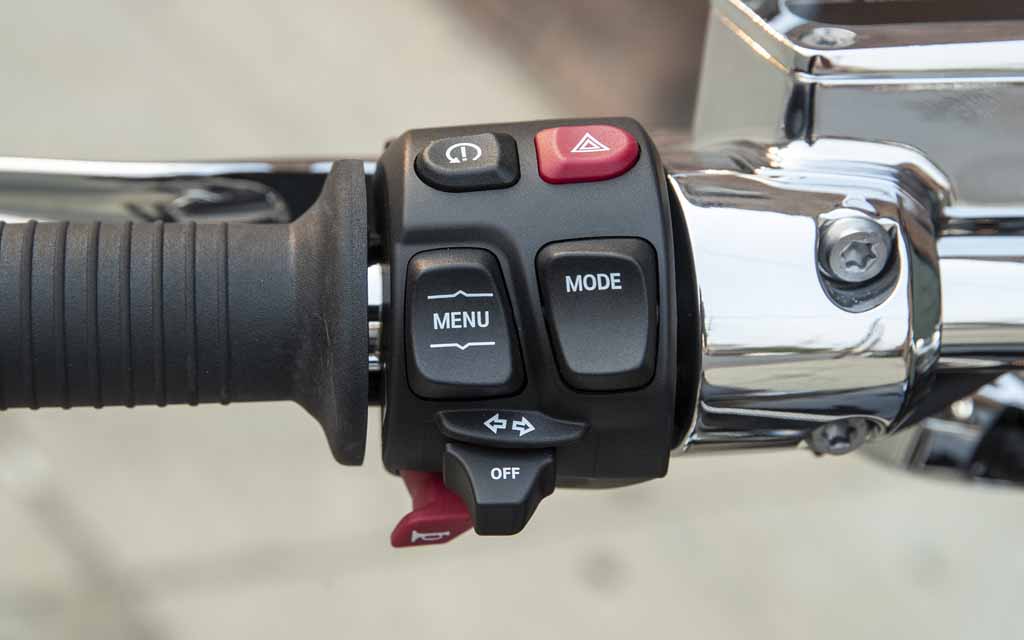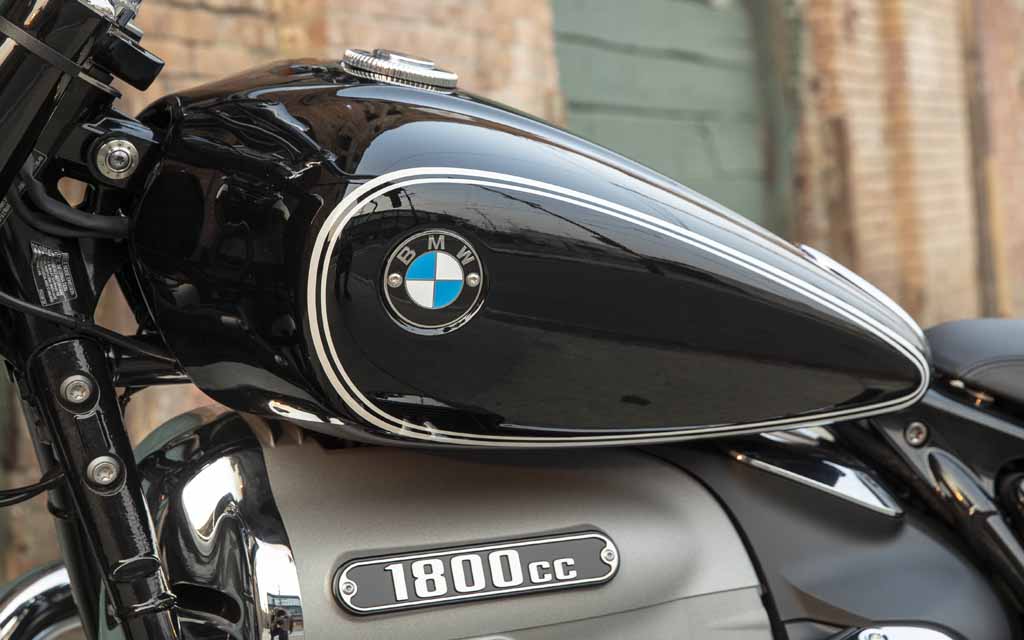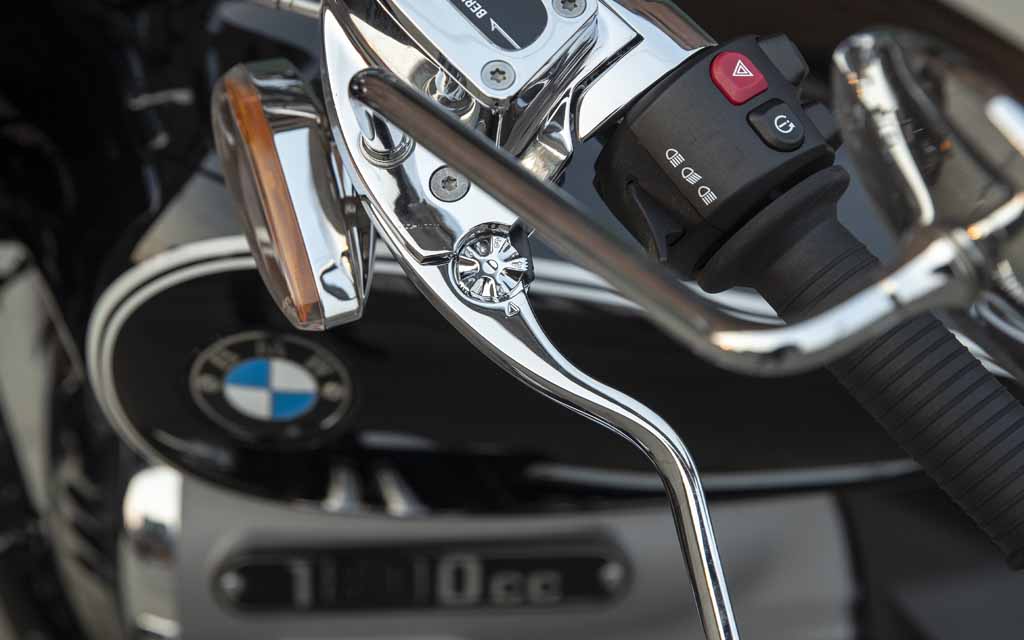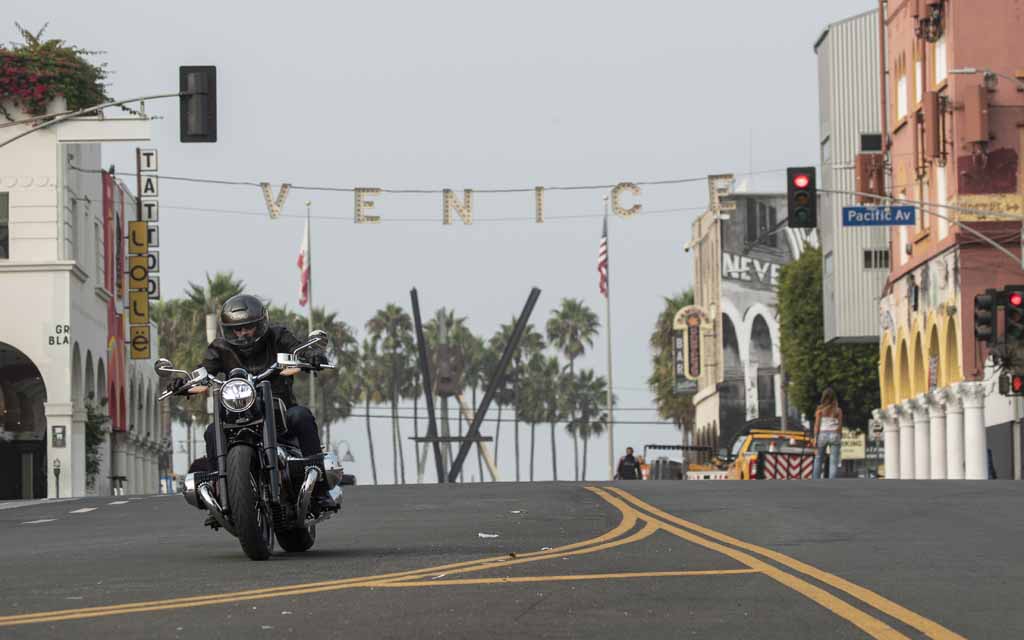A cruiser unlike any other
It’s an homage to the styling language of BMW’s R5 from 1936 combined with the American cruiser ethos of long and low. And big. It’s almost unnerving to see 901 cc cylinders poking like caricatures from each side of the Boxer engine, and it’s a sight you can’t get anywhere else.
The R18 has so much presence that it’s impossible not to gawk at it. There is no plasti-chrome here, just high-value metal housings. The open-running nickel-plated driveshaft is a visual delight. A hardtail-look rear suspension combines with black fork covers and classic white pinstriping to mimic the R5. Air/oil-cooled cylinders mean there’s no unsightly radiator to try to hide. An ultra-clean look is provided by hidden wiring and brake lighting incorporated into the turn signals.
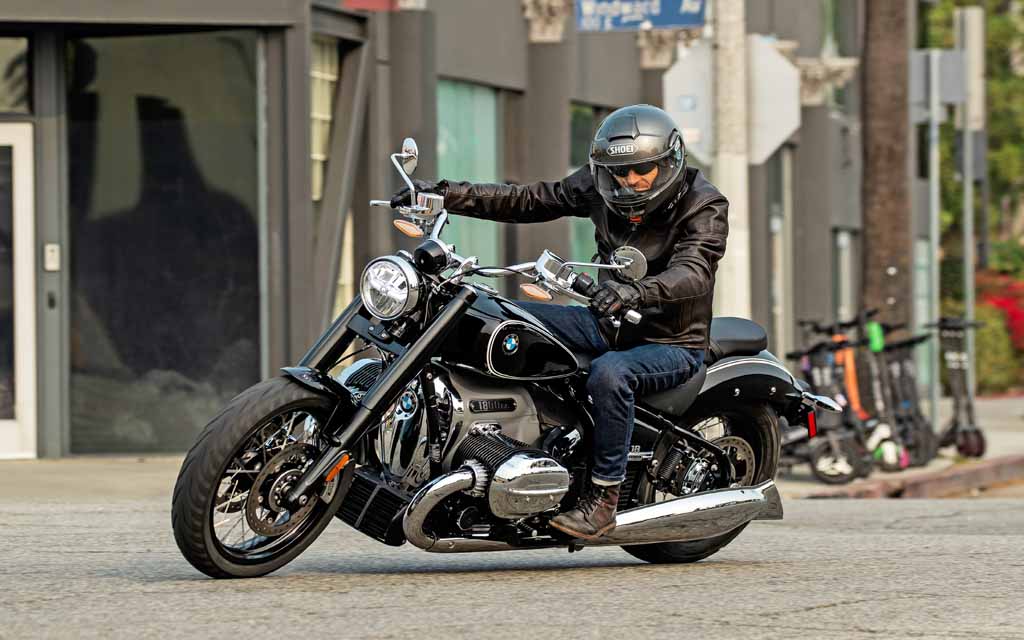
But, wait a minute. Aren’t cruisers a dying breed?
According to BMW, cruisers account for nearly 49% of the American market, so it’s not terribly difficult to make a business case out of cutting a slice out of the premium cruiser market for itself. BMW also notes there is a level of “Harley fatigue” in the cruiser market, opening an opportunity, and it doesn’t expect many OEMs to be investing in this market in the near future.
“This is a perfect time to take this chance (in the custom cruiser market) and we are very bullish on it,” says Vinnie Kung, product manager at BMW of North America. Market research says there are a lot of younger custom cruiser customers who are open-minded about brand loyalty. The age demographic is 40 years old. BMW also expects many of its current customers will want to diversify their garage with an R18.
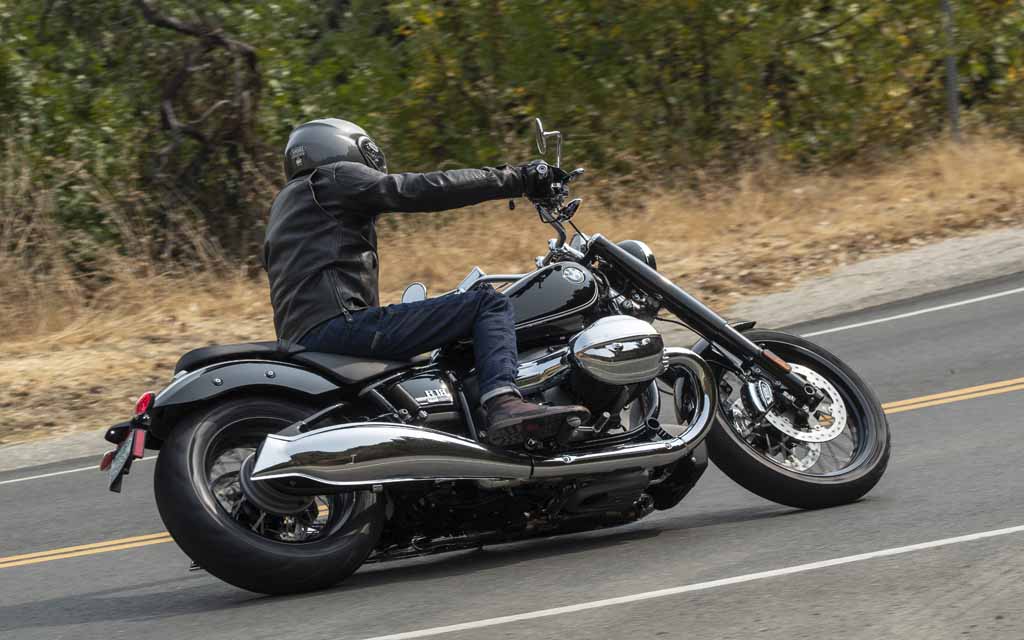
BMW market research dictated that the R18 “has to be as American as possible to do well globally,” so Harley-Davidson’s Softail Slim and its 107 cubic-inch V-twin was selected as the target. As well, the engine needed to be at least as big, so that’s how those giant cylinders came to be, combining to 1802 cc and 110 c.i. “The relevance of cubic inches couldn’t be ignored,” says Edgar Heinrich, BMW Motorrad’s design chief.
That giant flat-twin motor plays centre stage in the R18. Those voluptuous air-cooled cylinders nearly as wide as the handlebar breathe through four valves per cylinder actuated by pushrods. Valve adjustments are accomplished via simple screw/locknut adjusters. A ride-by-wire throttle provides three riding modes: Rain, Rock and Roll. Roll offers smoother throttle response than Rock’s, with the latter providing a party trick of idling as if it has a lumpy hot-rod camshaft, shaking the handlebar quite visibly at idle. The effect is initially cool but eventually irritates. Combining the smoother idle of Roll with the more direct throttle response of Rock would better suit my tastes.
The uber-Boxer thuds to life with a twist, rotating the chassis to the left as the hefty longitudinal crankshaft spins to life. A pleasingly deep rumble blats out of the Art Deco–inspired mufflers. Motorrad engineers tuned this mill for instant grunt rather than top-end power, punching out more than 110 lb-ft of torque from 2,000 to 4,000 rpm. Diesel- like punch is available anytime, thrusting the R18 forward with enviable cruiser alacrity. Claimed peak power (91 hp) arrives at just 4,750 rpm, so it’s best to shift early and avoid the vibration that accompanies higher revs.
There’s no getting around the fact that the R18 is big. At 345 kg with its 15.1-litre fuel tank full, it’s a hefty machine and 40 kg heavier than a Softail Slim. The engine and gearbox unit weighs 111 kg even before you add a motorcycle to it. A wheelbase nearly 10 cm longer than the Softail’s adds to its unwieldiness. The bike twists around its crankshaft when the engine is revved at a stop, and a rider can also feel its influence at low speeds, making low-speed manoeuvres tougher than most.
Those gigantic cylinders play a significant role in the R18’s ergonomic triangle, forcing a rider’s feet to reside behind the big jugs rather than being stretched out ahead like they would be on other cruisers. This isn’t usually a problem, but it becomes one when adding a cruiser-appropriate low seat, here at 688 mm (27.1 in.). This shrinks legroom, which will punish NBA players and other tall riders.
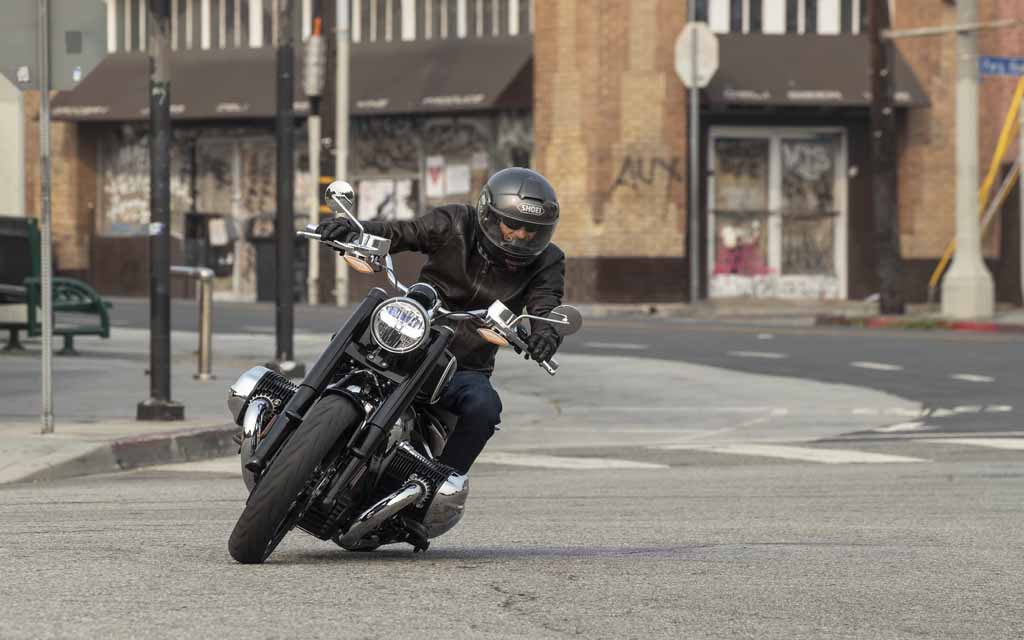
And then to create as much room for legs as possible, the footpegs are low. Really low. They drag at even modest lean angles, and I can’t recall another bike that touches down so early when leaned over. Sport-minded riders will be frustrated.
Bar-hoppers will tolerate it. All riders will prefer a seat with more padding. BMW graciously offers the option of a taller seat at no extra charge, which is likely a smart choice.
The 49 mm Showa fork offers reasonable compliance with its 120 mm of travel, and response from the non-rubber-mounted handlebar is direct and accurate. The bar bend leans a rider forward further than most cruisers. The R18’s chassis is willing and stable, but its sporting potential is held short by the cornering-clearance issue. Out back, there is just 90 mm of stroke in the Sachs shock to absorb bumps. It performs adequately for the most part, but big hits will make you wish for more cush. The firm seat doesn’t help.
The R18 one-ups the Softail Slim by having dual-disc front brakes; the Slim has just one to the twin 300 mm rotors and Brembo calipers on the BMW. A soft initial bite ramps up nicely to provide secure stopping power. It is also endowed with cornering-ABS and is a partially integral system that applies one piston at the rear when the front lever is pulled to deliver extra stability with no noticeable intrusion. The foot lever acts only on the rear brake.
The R18 has a count-up tripmeter when the tank gets to its reserve level, but there is no actual fuel gauge. It seems a strange omission from what’s billed as a premium cruiser that otherwise enjoys nice features like self-canceling turnsignals, traction control, and drag-torque control that reduces engine braking for smoother throttle transitions. The First Edition model tested here also includes hill-start control and reverse assist that uses the starter motor to easily back the beast out of tricky parking situations, as well as an adaptive LED headlight that shines into corners when leaned over.
The visually striking R18 is one of the most character-rich motorcycles on the road today, and it’s an impressive interpretation of historic BMWs supersized for cruiser consumption where being large is desirable. During our time with it, the R18 received an outpouring of positive reaction from a wide cross-section of riders, including many of the Harley faithful.
The majestic Beemer is uniquely appealing, but it’s also BMW’s least dynamically impressive motorcycle, so it will be interesting to see how the market reacts to it. More than half of R18 production will be directed at the U.S. and Canadian markets. BMW optimistically predicts sales of the R18 will nearly equal the brand’s iconic R1250GS, which, if true, would be a staggering achievement for the company.
2021 BMW R18 REVIEW
By Bertrand Gahel
STURGIS IMPREGNATES BERLIN
Well this was unexpected. We’ve been seeing images of this new R18 in various forms for years now, but I never could have imagined actually riding it would be so surprising, shocking, even. Look at you, BMW, swinging just like that from German efficiency to American coleslaw wrestling. Oh, there’s still plenty of BMW goodness in the R18, no worries there, but that’s not what the bike is about. The R18 is before anything else a remarkably well executed high-character cruiser. How in the world did the Germans succeed in capturing better than anyone else (and many have tried) the essence of the traditional American cruiser experience? I swear one day I’ll get the answer directly from them and I’m sure it’ll be quite a story.
But for now, I don’t know who exactly over at BMW is responsible for this extraordinarily unusual Berlin-built cruiser. I can, however, confirm the people responsible definitely know their shit when it comes to high-character heavyweight cruisers. Even Harley doesn’t build ‘em like that anymore. It takes balls to produce a bike with an engine character that strong, because the fact is many will think something’s wrong or awkward about the R18’s monster Boxer. And they’ll choose a cruiser made for the masses instead. Which makes this R18 one for the connoisseur.
Very few cruisers come to mind if the R18 is to be compared, engine-wise at least. Harley-David- son’s now unfortunately defunct Dynas are the most obvious point of reference. For those who have never ridden a Dyna, they’re less than a mechanical spectacle. At idle, their rubber-mounted big twin swings back and forth so much inside the frame it blurs the rider’s vision and shakes the front tire up and down enough you’d swear it lifts it off the ground. But get going and everything becomes magically smooth by 2000 rpm. Harley recently killed the Dyna platform to instead focus on bikes that behave more normally: Softails. A bad decision if you ask me.
Part of what’s so surprising about the R18 is that for the past 15 years at least, BMW has also been prioritizing bikes aimed at the masses. The best example is how each new generation of its signature Boxer twin offers less character than the prior: there’s always more power, but also less pulse and less noise. It makes for an easier sale to the average rider, but it also eats away at character. It is what it is. If a product with less character sells more than the one with more, then it’s seen as the obvious right direction. But is it? I think it’s a mistake. I think brands should always keep and cherish at least one product that makes them unlike any other. That’s if they’re lucky enough to have such a product in the first place. It won’t be a top seller, but if only to demonstrate the originality and edginess a brand is capable of, it still needs to exist. That’s my belief. Which is why I like the R18 so much, but also why some might not appreciate it.
I can’t say I know for a fact that the R18 was meant to be that unique and edgy a product for BMW, but I just don’t believe you get to a bike like that by accident. Its engine particularly, but also its style are the main elements that make it so special. At three feet wide, the incomprehensibly mas- sive Boxer is very much part of the styling. Visually, the 1800 cc twin is overwhelming. This is no regular Boxer. Deeply finned, air and oil cooled and adorned with the most massive push rods ever on a bike, it looks like a section of a WW II-era radial airplane engine. Looking at the R18 from the front, the big Boxer is all you see. It’s a majestic and hypnotic machine, as much visually as me- chanically. To call it a Boxer on steroids doesn’t do it justice; it’s more like the full Hulk treatment.
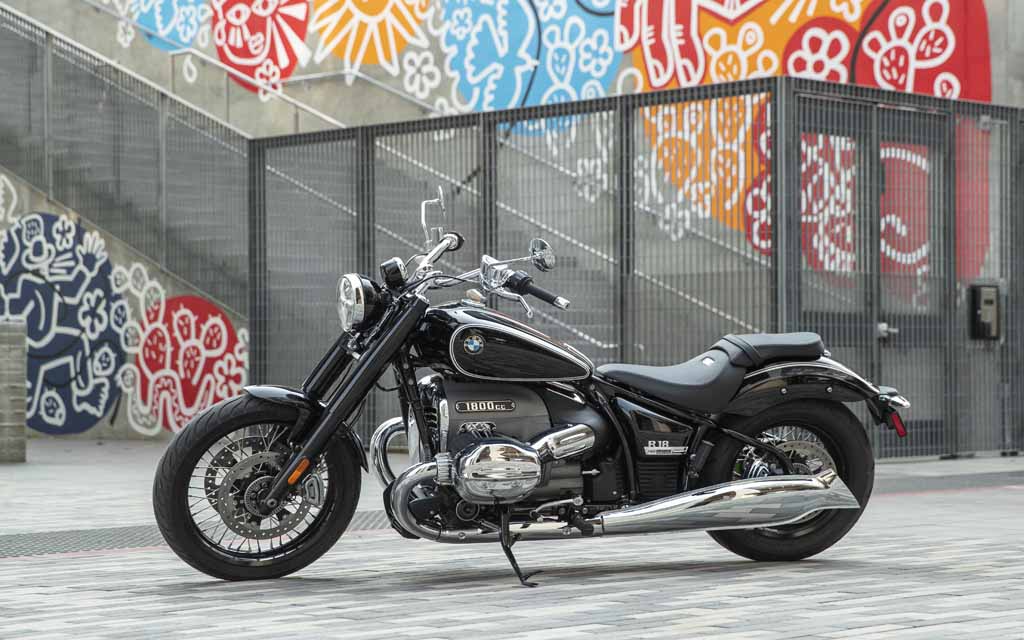
Every inherent feature of a BMW Boxer twin is there, just miraculously amplified. You find this out the moment the engine starts, when the whole bike is unexpectedly pushed to the left. On other BMW Boxers, this torque reaction can be felt, but on the giant R18, you actually have to be care- ful about it. Snap the throttle at idle with the side stand up and you better have both feet planted because it will swing to the left as if someone pushed the bike by surprise. At crawling speeds, in traffic, if the clutch is in and the throttle blipped, the whole bike will steer to the left and you’ll have to correct the trajectory. Each piston pulse is felt, especially during acceleration, but the engine be- comes smooth when cruising. Each gear change is accompanied by a Harley-like heavy clunk. Clutch effort is light, low rpm torque is massive and per- formance is very good, about as good as it gets for an air-cooled heavyweight cruiser.
As for the rest, the R18 is more or less what you’d expect from a modern cruiser: super low seat (al- though not super comfortable), not a whole lot of suspension travel (although both the front and back perform very well within that travel), superb finish and cool look (although the Honda Shadow rear fender and weird fishtail mufflers don’t match the classiness of the rest), decent brakes (although the front demands a good deal of pressure at the lever to deliver its best performance) and excel- lent handling with decent ground clearance (al- though obviously not unlimited). Last but not least is maybe what will be one of the most polarizing features of the R18: ergonomics. Most will blame the protruding cylinders of the Boxer layout for the admittedly cramped legroom. But a Gold Wing has the same engine design, so the real issue here is the very low seat which results in a short seat-to-peg distance. Like the strong engine character, it’s not a riding position for the masses. I personally didn’t mind it at all. First, it’s sort of the natural continuation of this unusual machine; second, mid-mount controls or even weird ergos certainly aren’t that uncommon on cruisers and this case is no worse than how a whole bunch of Harleys contort their riders; third, on the short to medium distances the R18 is meant to be ridden, it’s not that bad, really.
So what we have here is a very unusual cruiser with many very unusual characteristics. It’s not for everyone. Riders who’ll appreciate it the most are those who’ve sampled a great deal of cruis- ers and have a strong preference for uncommon and character-heavy engines. For this group, to which I belong, the R18 is a revelation, an almost impossible achievement from a manufacturer other than Harley-Davidson and, mostly, an immensely enjoyable riding experience. For the aver- age cruiser buyer who prefers the feel of a smooth V-twin in a traditional-looking package with classic feet-forward ergos, there’s really good news: there are numerous other models that fit that description to a T.
